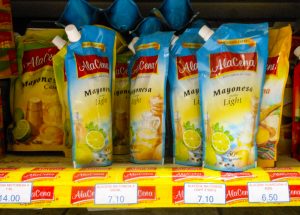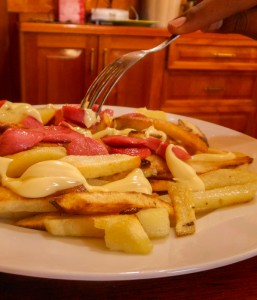Mayonnaise Conquers Peru

Something yellowish white and creamy delights the people of Cuzco so much that they can hardly seem to eat without it. Wherever you go, private home or fancy restaurants you will find it. But it is not indigenous to Peru, though there is an old tradition you might connect it to, but it is more modern.
I am talking about mayonnaise, called mayonesa in Spanish. As you might gather, the root of its name in both languages is French. This is strange because the Spanish have their own sauces made with oil and lemon juice that are a delight. If you add garlic you have the aioli that is so popular all over the developed world today.
Mayonnaise is similar but not the same. The difference really lies in that mayonnaise come is bottles and personal packages. It is industrial while aioli tends to be homemade or chef-made at the moment of consumption.
Sure French cooking took the Anglo and Latin American urban upper middle classes by storm in the nineteenth century. It seemed the pinnacle of refinement–and of state formation. The court of the Sun King Luis XIV had impact all over as a paragon of leadership and culture.

In Peru, though, that refinement probably came in the bowels of an English merchant vessels maybe even accompanied by a gunship of the English King. This was the time when the guano islands off Peru’s coast made Avalon fertile and let it have the highest yields from its agriculture of any place on earth. In return Britain brought the goods of its industries to Peru and pushed railroads throughout the country to extract minerals and alpaca fibers, raw material, leaving soccer, beer, and notions of bourgeois gentility.

While that may be where Peru first got notions of mayonesa, something else happened mid-twentieth century when multinational corporations –aka US firms, came with American industrial food. In this way bottles of Hellman’s mayonnaise arrived and Hellman’s became the standard for a while.
Nowadays you see many others, such as Alacena. This corporation began as a company that specialized in vegetable oils. The production of mayonnaise was a natural sideline and in this is another point.
Industrial mayonnaise is not made from olive oil, but from industrial vegetable oils.
Without an industry producing extracting oil from different plants both for home and industrial use it would be hard to have the bright bottles of Hellman’s on the shelf.

As a result, mayonnaise spread with the massive growth of Lima and then secondary cities like Cuzco, as well as with the appearance of mass culture, television and such, in the post WWII period.
It is not surprising that other foods that took off during that same time–sandwiches, pollo a la brasa, salchipapas, and so on, require it as part of their proper concoction.
Since then, mayonnaise seems to have tied into something particular to the taste of masses of Peruvians. Mayonnaise is even replacing ketchup (another industrial good) and the native hot sauces on many tables and is being used on ever more foods.
We indeed live in the magically realist day of the mayonnaise. Its little packages increasingly appear everywhere. There is nothing more common than mayonnaise, it seems even more common than the last name Perez.





Central & South American cuisine, limes everything they do as foods. That taste just gets old and even overpowers the main course. Lime is supposed to be a palate cleanser. They put it on breaded fish, their rice, Ceviche and so forth. Chipotle’s cilantro & lime rice is a fine line between too much and the right amount of lime for flavoring. And quite often they blow it as “too pungent.”